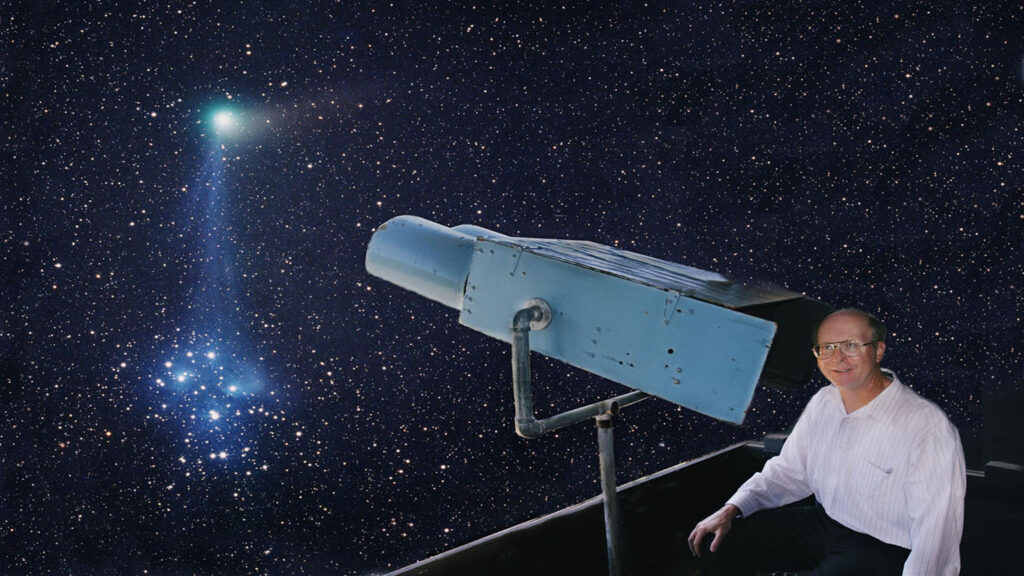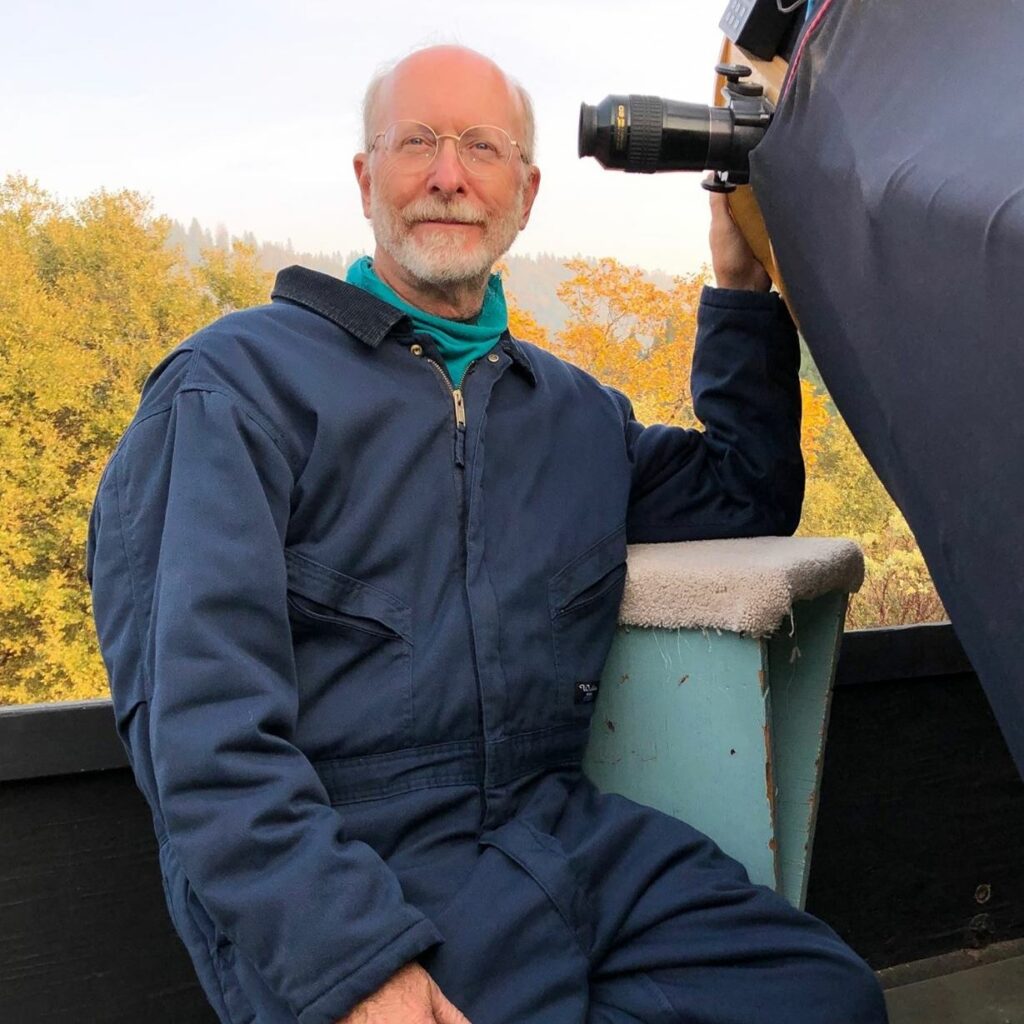The Discovery of Comet Machholz, 1994r
October 8, 1994
By Don Machholz
The year 1994 was already a great year. I had written an article for the Association of Lunar and Planetary Observers about the lost and possibly returning Periodic Comet deVico. On June 1 I started writing a book about the Messier Marathon. On July 6 I visually discovered my seventh comet. Five weeks later, on August 13 I discovered my eighth comet, a periodic comet that had split into pieces. By October 1 I had done 219 hours of visual comet hunting for the year.
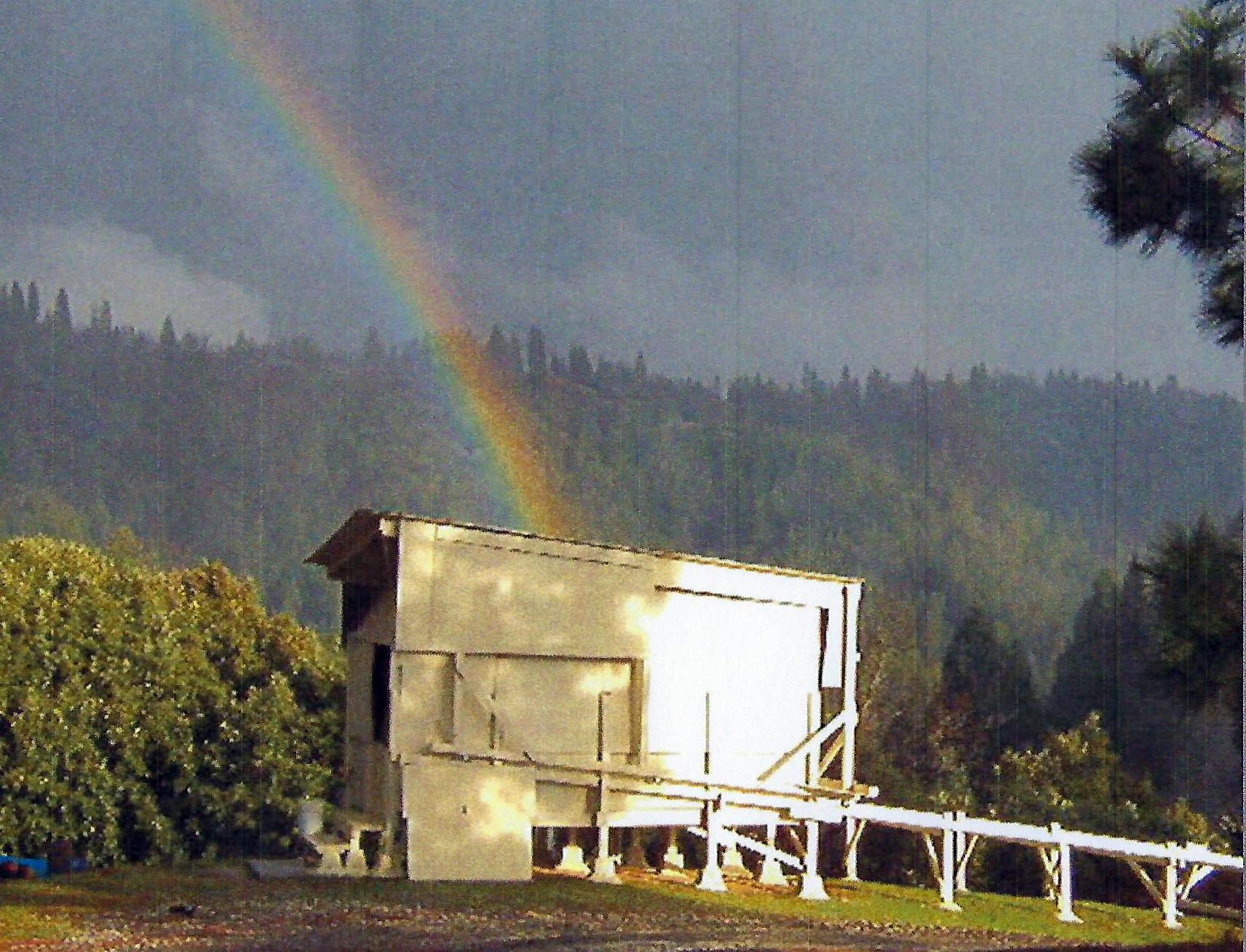
For the past year, I had been comet hunting from my roll-off observatory, designed so that the side panels could be removed with the roof still closed and I could comet hunt with my homemade 5” binoculars. Also housed inside the observatory was my 10-inch reflector on an English Yoke mount, which requires no counterweights.
My July comet discovery was with the 10-inch, while the August one was with the large binoculars.
Friday, October 7 was my birthday and that evening my wife, our two sons and I went out to dinner in downtown Colfax. When we got home, I looked at the star Arcturus in the western sky, something I have gotten into the habit of doing every year on my birthday. I look at it and remember that night in 1965 when I received my first telescope, a 2-inch refractor, and took it out into the back yard to look around. It had 75 power and a small field of view, frustrating me almost to the point of quitting until I saw the planet Saturn through the scope three nights later.
But this night was not that night. This night I took my 6” Criterion Dynascope out of the garage and set it up in the turn-around area just east of my house. That is the darkest place in the vicinity of our house and gives a good view of the southern horizon. I was attempting to observe the comet that I discovered in July, Comet Nakamura-Nishimura-Machholz (1994m). It was heading south and dimming, and I wanted to get at least one last look of it. It was only 8 degrees about my southern horizon and a couple of degrees above the trees on a ridge south of me. I knew where it was and had the field in the telescope, but I could not see the comet. After about fifteen minutes I gave up on it. This was sad, it is always sad and a bit melancholy when I will no longer see a comet that I have discovered. It had put on a good show.
But Periodic Comet Machholz 2, the comet I had found in August, was still visible. With its two main components, it would rise above my eastern horizon at 3 AM. I would go to bed soon and get up in a few hours to see that comet during my next comet hunting session.
I did not know this at that time, but as I was facing south lamenting the loss of Comet 1994m, directly behind me and barely five degrees above the northern horizon, lay an undiscovered comet which I would happen upon in nine hours. In the next few hours, while I sleep, this comet will reach its lowest point in the northern sky, then begin climbing in my northeastern sky. I will meet this comet when it reaches an altitude of 52 degrees.
I was in bed by 10 PM and got up about 2 AM for comet hunting. The sky was clear this Saturday morning, and it was cold. I began comet hunting at 2:20 AM, using the 10-inch reflector. It has a 32mm eyepiece to which I had pressed a -4 diopter lens into the bottom of the eyepiece to increase the effective focal length of the telescope slightly and increase the magnification to 36x. I had used the same combination to discover the comet in July.
The area I covered was the equatorial area, which was in my south south-eastern sky. It was Areas 37 and 38, from 4 through 6 Hours Right Ascension and from Declination +20 to -20 degrees. This took 90 minutes of eye-to-eyepiece sweeping and then I looked at my periodic comet. At 4:10 I swung north to cover area #17, from 8 to 9 Hours Right Ascension and from Declination +20 to +60 degrees. I had been sweeping this area the previous morning when clouds come in and ended my session.
At 5:07 AM the radio began playing the song “Hard Habit to Break” by Chicago. While the opening notes were playing, I picked up a faint fuzzy object and knowing that no known galaxy was in the area immediately began to suspect that this was a comet.
To be sure, I checked out my Atlas of the Heavens field map and saw no galaxies in this location. Then I went to my Uranometria and again saw nothing. I placed a pencil mark at the location of the object. I also put an “x” to cross out a pencil mark I initially accidentally placed on the wrong spot (I have no eraser). Since I had to attempt to detect the motion of the object to be convinced it is a comet and to give the Central Bureau of Astronomical Telegrams at the Smithsonian Astrophysical Observatory and the idea of where it was headed for confirmation, I made a map on the back of my observing log sheet. It was 5:15.
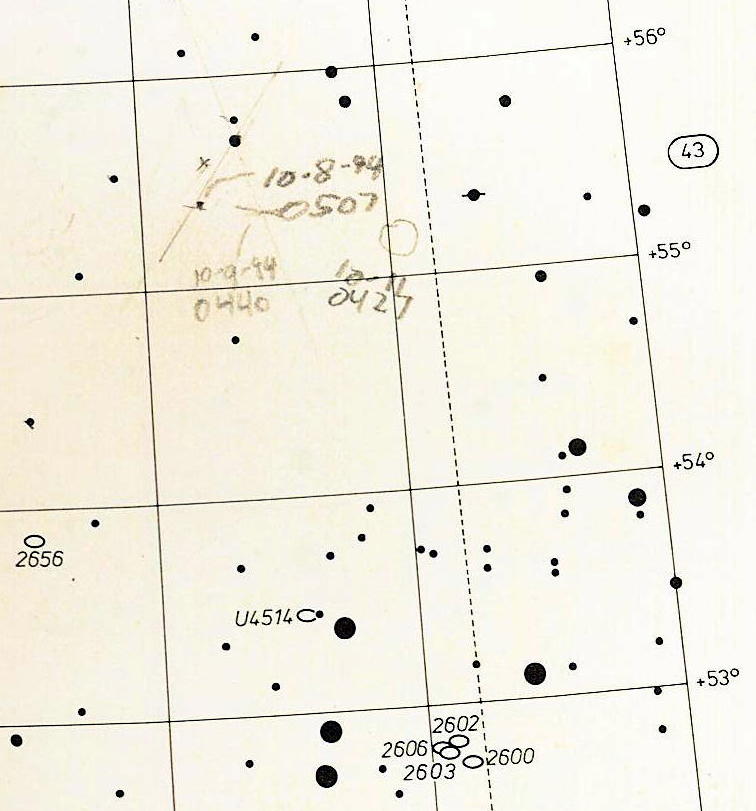
I then went into the house and at 5:31 AM dialed up the Smithsonian on my computer. They have a service which will tell you if a comet is at any particular location in the sky. I entered the location and the result was “No objects found”
I then left a message: “I am presently checking out an object at 08h 41m, +55.5 deg. It is mag 11, maybe a comet or may just be a small group of stars. More later. Don Machholz”.

By 5:38 I was out at the telescope again. I was not certain of any movement, but I still had another half hour before the sky would begin to brighten. I doubled the magnification and the comet was not more apparent, which is odd for a small comet. But it was clear that it was not a small group of stars.
I continued watching it and by twilight, I suspected it might have moved but I could not be certain.
At 6:35 I was on the phone again with the Smithsonian. More information was exchanged, and they said they would try to get confirmation.
At 5:20 that afternoon I received a call from Dr. Marsden of the Smithsonian Astrophysical Observatory saying that it had been imaged by Klet Observatory in the Chech Republic. Looking over their position and magnitude estimate (16.5, much fainter than my estimate of 11.5) it was uncertain if the comet was actually imaged and measured. Nevertheless, despite the doubts, Dr. Marsden said they would issue the announcement trusting my observation.

This comet was found 55.25 search hours and 34 sessions after my previous find two months prior. This was the fourth comet discovery with the 10-inch telescope, my fifth comet discovery from Colfax, California, and my ninth comet discovery since I began systematically searching for comets in 1975.
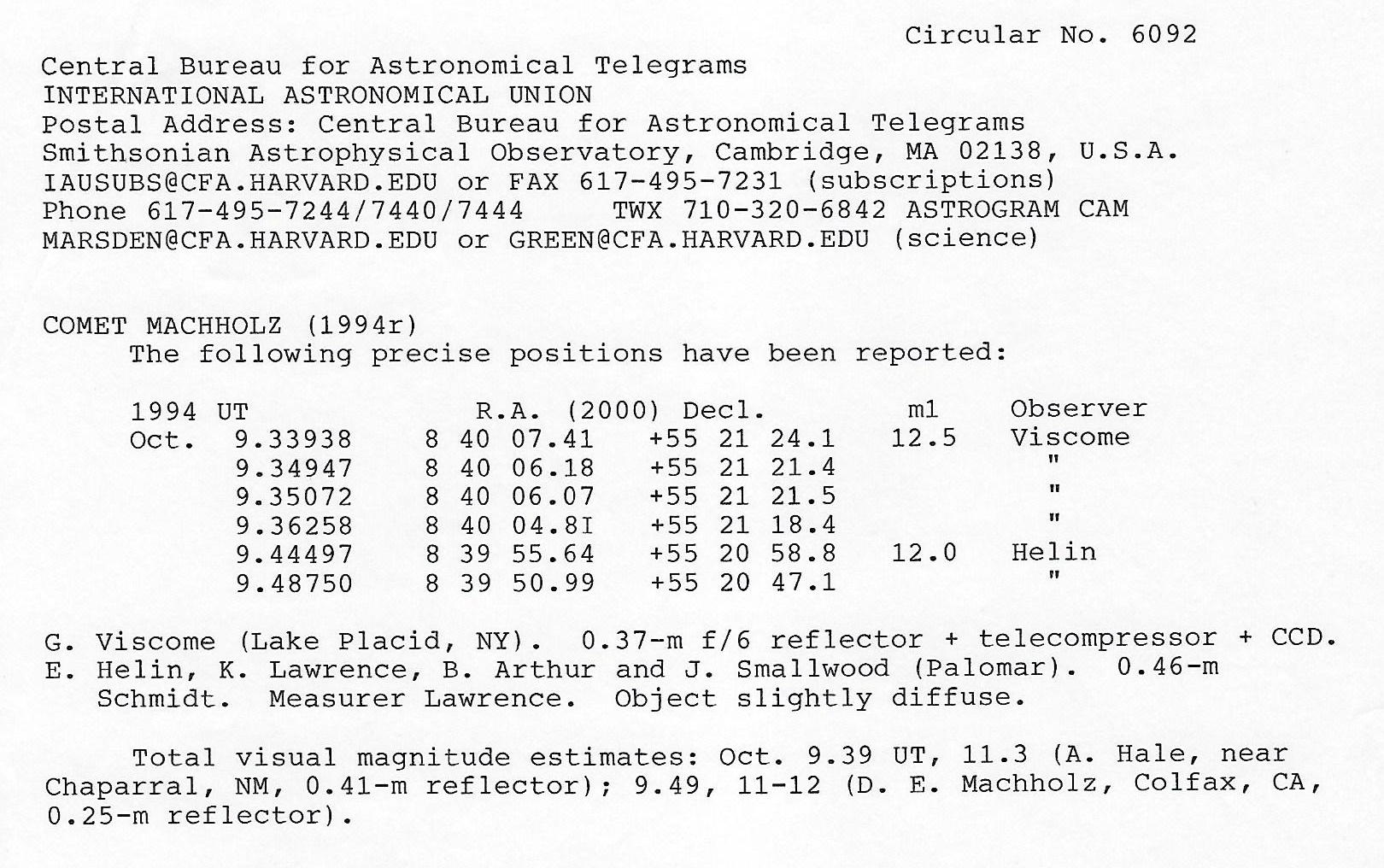
Over the next few days, more accurate positions were obtained for the comet along with some visual magnitude estimates.

Meanwhile, I was also plotting its position on my Photographic Star Atlas. The comet was moving rather slowly, about 16 arcminutes per day. No wonder I had trouble detecting motion in one hour of observation.
As more observations came in the comet orbit could be more accurately calculated. Klet Observatory asked us to ignore the confirmation positions from October 8.8, as they were incorrect. The orbit showed that the comet reached its closest point to the sun a few days before I discovered it, at a distance of 170 million miles. The comet was 160 million miles from us but would close to within 92 million miles of us by late November. That would cause it to brighten slightly. As it turned out it brightened aggressively, becoming magnitude nine in early December. The comet crossed the ecliptic headed south on December 13, and on December 15 a nearly full moon passed in front of it. With the comet so faint, I doubt anyone saw the comet disappear behind the moon or reappear from behind it later. When new comet-naming rules rolled out the next year, this comet became known as Comet 1994 T1 (Machholz).

After these three comet discoveries in just over four months, I continued my comet hunting as before. It would be almost ten years before my next comet discovery.
End.














